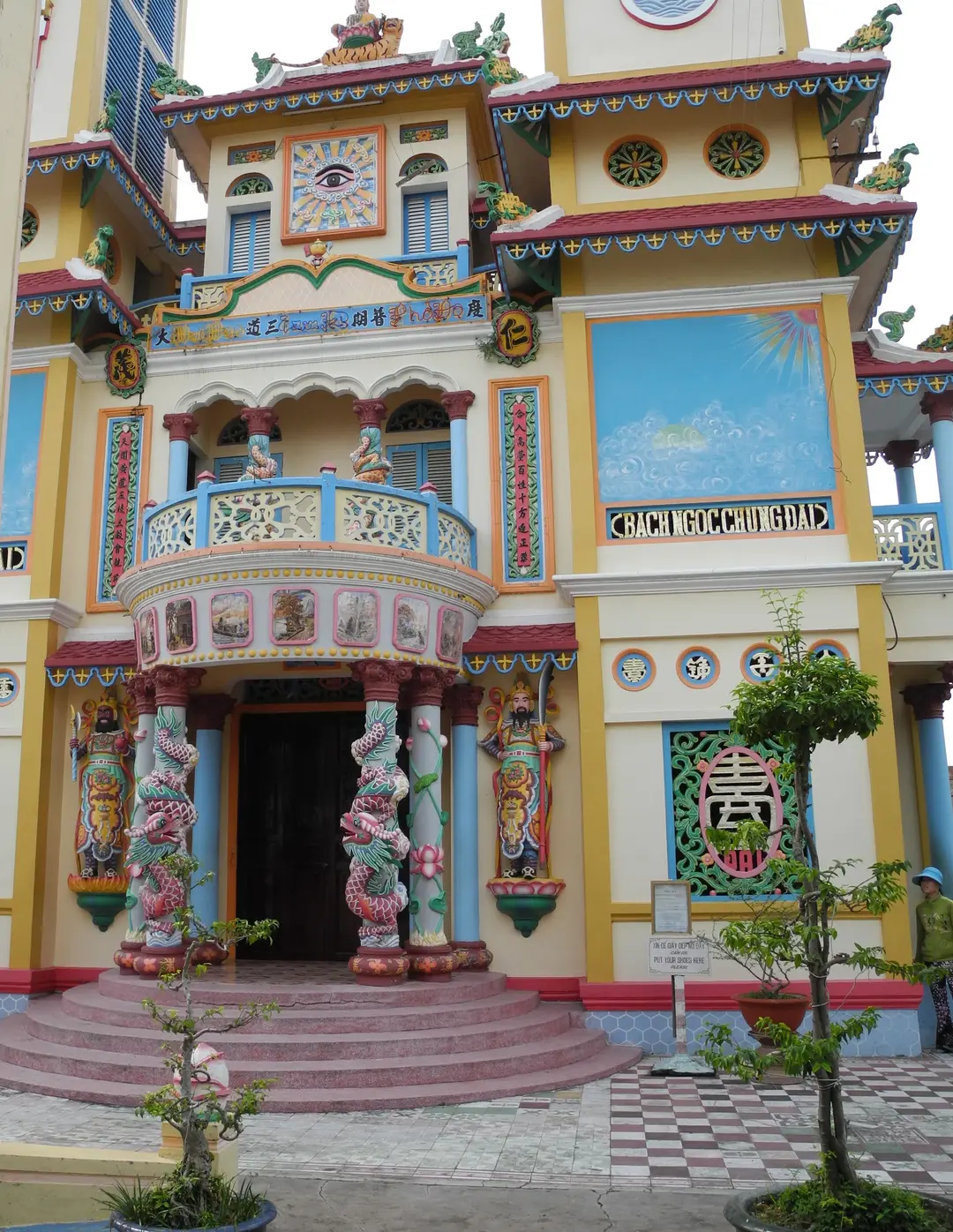For those seeking insight into a my tho temple, this guide presents essential information about two of My Tho’s iconic religious sites, including their names, locations, history, and highlights. Whether you plan a visit or simply wish to learn more about local heritage, you’ll discover key facts to help make your sightseeing experience smooth and memorable.
Name, location, and a brief description of the temple in My Tho
Vinh Trang Pagoda
Location: Nguyen Trung Truc Street, My Tho City, Tien Giang Province, Vietnam.
Brief Description: Vinh Trang Pagoda stands out as the largest and most famous my tho temple in Tien Giang Province. It has been recognized as a national historical and cultural heritage site, attracting travelers and pilgrims alike. Originally constructed in 1849, the pagoda is celebrated for its harmonious blend of Vietnamese, Chinese, Khmer, and Western architectural elements. Visitors can admire beautifully carved woodwork, striking Buddha statues, and tranquil gardens filled with shade and blossoms. The pagoda presents itself as both a spiritual sanctuary and a cultural gem within the Mekong Delta.
Opening Hours: Vinh Trang Pagoda is generally welcoming guests daily from 7:00 AM to 6:00 PM.
Entry Fees: Entrance to this my tho temple is free for all visitors.
Photos of the Temple: See 824 candid photos on Tripadvisor, including Buddha statues, lush gardens, and ornate temple architecture.

Directions/Map: To reach this my tho temple from Ho Chi Minh City, take National Road 1A towards My Tho City. From the city center, follow Provincial Road 819 for approximately 3km, turn left at Vinh Trang Park, and continue 300m to reach the pagoda. It is accessible via bus, taxi, or motorbike from My Tho or neighboring provinces.
Contact Information: Specific contact details are not provided by most sources.
Cultural or Historical Background: Vinh Trang Pagoda began as a humble leaf hermitage established by Bui Cong Dat in the early 19th century before being expanded into a larger temple by Thich Hue Dang in 1849. This my tho temple has undergone several renovations, resulting in unique architecture that fuses Vietnamese, Chinese, Angkorian, and European styles. In 1984, it was recognized as a National Historical and Cultural Relic, and in 2007, it was named in the Vietnam Book of Records as the first Vietnamese pagoda showcasing both Eastern and Western styles. Today, the complex serves as an active place of worship, a vibrant tourist destination, and a serene retreat known for its welcoming monks and tranquil gardens.
Cao Dai Temple
Location: Mỹ Tho City, Tien Giang Province, Vietnam.
Brief Description: The Cao Dai Temple in My Tho represents the heart of the Cao Dai religion locally, offering a spiritual retreat that is distinct from other my tho temples. It is devoted to a unique faith that draws upon Buddhism, Taoism, Confucianism, Christianity, Islam, and indigenous beliefs. As a result, this temple is characterized by vibrant, eye-catching architecture, laden with symbolic motifs and a soothing aura. The Cao Dai temple is a testament to religious harmony and spiritual inclusivity.
Opening Hours: Specific operating hours for this my tho temple are not widely documented.
Entry Fees: There is no clear information on entrance fees for the Cao Dai Temple.
Photos of the Temple: Not directly found; typically named “Đền Thờ Cao Đài” in local maps and tour listings.

Directions/Map: Mỹ Tho is about 70km southwest of Ho Chi Minh City, easily reached by bus from the Mien Tay Bus Station or by private car. Within Mỹ Tho, visitors can arrive at the temple by taxi, motorbike, or bicycle.
Contact Information: No direct contact information is available in most resources.
Cultural or Historical Background: The founding of the Cao Dai sect in 1926 in Tây Ninh paved the way for temples like this my tho temple to spread throughout southern Vietnam. Emphasizing the unity of all spiritual paths, the Cao Dai faith and its temples epitomize a message of respect, peace, and acceptance, inviting visitors to experience a vibrant and harmonious religious tradition.
Tips for Visiting My Tho Temples
Ideal Time to Visit
To fully enjoy the my tho temple and its surroundings, aim to visit in the early morning or late afternoon, when the crowds are lighter and the weather is cooler. For the best climate, try scheduling your trip from December to April during the dry season, when rain is uncommon and sightseeing is especially pleasant.
Suggestions for Photography
The best time for photography at the my tho temple is during the soft morning or golden late afternoon light, which accentuates architectural details and gardens. Notable spots include the temple façades, ornate gates, serene courtyards, and giant Buddha statues. Focus on natural framing with trees and avoid harsh midday sunlight for optimal results.
What to Bring
For a comfortable visit to any my tho temple, pack lightweight, modest clothing, a hat, sunscreen, and bottled water. Don’t forget your camera or smartphone for photos, and consider bringing an umbrella for sun or rain protection. Modesty and comfort are key, especially if you intend to spend time in temple courtyards or gardens.
Cultural Etiquette for Visitors
Dress Code
When entering a my tho temple, always wear attire that covers shoulders, upper arms, and knees. Avoid shorts, short skirts, or sleeveless tops. Opt for simple, neat clothing to show respect for the sacred setting, and remove hats and sunglasses before entering the main prayer halls.
Respectful Behavior
Behave quietly and thoughtfully throughout your my tho temple visit. Refrain from loud conversations and avoid touching sacred objects or statues. Always greet monks or worshippers with a polite nod, and follow signs or staff guidance regarding areas that may be restricted to lay visitors.
Temple Offerings
Visitors may offer incense, flowers, or symbolic gifts at altars in a my tho temple. Place offerings quietly and respectfully at designated locations, never directly on statues. Observe local customs or inquire discreetly of staff regarding proper procedures to ensure your actions are appreciated.
